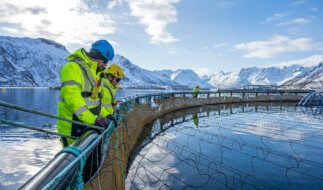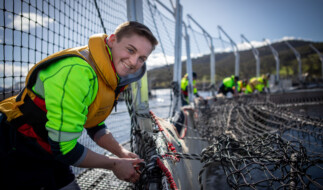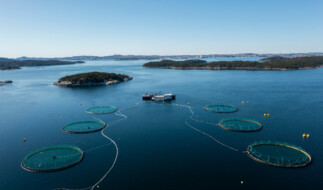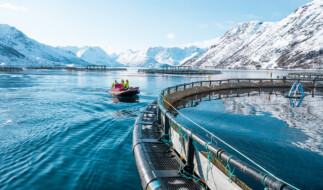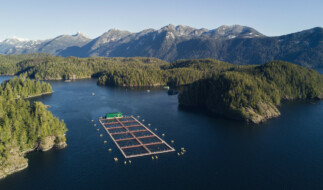Tasmania's Place in the Global Food System

The concept of ‘think global, act local’ resonates strongly for the global food system. The challenge we, in the food system, are faced with is producing more high-quality food for the world’s growing population, with minimal impact on the environment, and all while reducing greenhouse gas emissions to meet global climate goals. This requires change and innovation at speed and scale.
A visit to GSI members in Tasmania
My job sits in this intersection of global and local. I lead GSI, a global initiative on a mission to improve the sustainability of the farming salmon sector. We achieve this by connecting member farmers from around the world to share challenges and opportunities that decrease environmental footprint and improve operations at the local level, in order to deliver high quality food that nourishes the global food system. By connecting the local and the global we strive to drive continuous improvements at the speed and scale our food system and society needs.
I recently set out to Tasmania to visit a few GSI members and find out more about how our work both at a global level in GSI, and at a local level through their operations, is contributing to the global food system sustainably and responsibly while supporting the local community. Here’s what I learnt during my two weeks exploring Tasmanian salmon farming:
When I first landed in Tassie, I was reminded of what great taste salmon have in locations – clean air, fresh crystal-clear waters, and vibrant ecosystems. All of which are precious and shared resources we must protect.
In Tasmania, the salmon farms are often located in small remote towns, and the industry provides a crucial employment opportunity for a range of jobs, but also encourages people to stay local rather than relocating to find work. But these ‘local’ farms are world class operations, at the cutting edge of using new technology to improve sustainability.
Technology and innovation are key
As I toured the farms and facilities, I quickly saw the focus on digital technology and new infrastructure, which offer the latest innovations in farm management. This modernization and digital approach are good for fish health, the environment and employee safety. One example is around salmon feeding, which has moved to remote control feeding from a central station. This allows highly trained staff to monitor individual fish behaviour with underwater cameras and AI technology to ensure they have the right amount of food as needed and reduce feed that may historically have drifted out of the pens. It also means that when intense weather systems pass through, workers can continue monitoring fish from the safety of the control centre. This intensive development of digitalization has been spearheaded in Tasmania, where they trialled one of the first AI programs and have since shared their learnings with other farming regions and producers.
On the topic of feed, Tasmania is home to two of the world’s largest feed companies, which gives farmers access to the latest knowledge in global feed development. What’s more, is that on average over 70% of the feed ingredients are sourced locally in Australia, so the footprint is drastically reduced as raw materials don’t have to travel far. In addition, given the locality of the farms and feed suppliers here, there is a unique ability to work closely on testing innovations in feed ingredients. Both feed suppliers here are working closely with the Aquaculture Stewardship Council (ASC) and their new Feed Standard to ensure the feed made in Tasmania meets the highest environmental and social standards for responsible sourcing. I was also fascinated by the logistics of the industry here, which gets fresh fish to the mainland in a matter of hours, meaning Australians have year-round access to the freshest fish all sourced locally, which significantly reduces the carbon footprint if it has to be imported in.

I met with GSI members and associate members to learn more about the local supply chain and feed production.
Tasmania is known for its rugged terrain and beautiful scenery, but it’s not all smooth sailing. As I toured some of the farm sites a little further offshore in aptly named Storm Bay, it became quickly apparent that some of the farm sites are really open to the elements. Often facing high-energy weather patterns, which the fish enjoy, the farms and equipment must withstand some of the toughest sea conditions imaginable. One example is the latest pen designs from Huon. These pens are larger and designed to withstand the elements and at the same time keep the number of fish within them lower to offer more space and support optimal welfare. This is one reason the salmon raised in Tasmania have some of the highest survival rates, despite the unpredictable weather conditions. Again, global innovation and technology being used to protect and withstand local ecosystems.
A big global focus right now is encouraging greater circularity especially in production industries, which I got to see firsthand in Tasmania. Tassal has built a rendering facility, which collects the by-products from the industry and through a highly specialized process, separates the fish oil from fish meal to develop high quality ingredients for pet food. This type of approach means there is minimal waste, improved circularity, and the pet industry has access to a more sustainable supply of raw materials.

I participated in several farm tours and learned about the innovative techniques happening at the farm level.
And while there are many more promising stories I could share about salmon farming, on entering Hobart it was hard not to notice the ‘toxic’ flag flying above a local newspaper building. It’s evident the sector still has work to do on building acceptance among some residents, and the message that continued change is necessary is agreed upon by residents and industry alike. The reality is, for all food sectors, merely being “good” isn’t enough for future challenges; we must continually improve our operations to ensure minimal impact.
Collaboration pairs well with transparency
My experience is that our global work in GSI can help in this, both connecting local companies to a global network of experts to share and learn from, as well as build greater transparency. Each of the companies, as part of their work in GSI, provides key environmental data publicly to share real-time performance of their farms and progress towards achieving goals. Just as importantly they share innovations that make significant improvements to sustainability.
Pairing transparency with collaboration and innovation is what will move the needle on meeting global food system goals with access to healthy and sustainable food. Collaboration is key: within the sector to enhance performance, with academia for research and innovation, and with policymakers for effective and fair regulations. Transparently documenting our journey of continuous improvement is essential to build the sector of the future.
